Accelerating to NetZero
“The Navitas goal is to ‘Electrify Our World™’ using next-generation power electronics and to enable and accelerate the transition to fast, efficient, clean forms of sustainable energy.”

Gene Sheridan, Co-Founder, CEO
Navitas: World’s First CarbonNeutral®-Certified Semiconductor Company
In May 2022, Navitas Semiconductor, industry-leader in GaN power ICs, announced that it is the world’s first semiconductor company to achieve CarbonNeutral®-company certification from the leading experts on carbon-neutrality and climate finance, Natural Capital Partners.
Achieving CarbonNeutral-company certification is another milestone towards Navitas’ mission to “Electrify Our World” and to help Navitas’ customers achieve their own sustainability goals.
Sustainability Report 2021
The transition from silicon chips to gallium nitride (GaN) will play a vital role in enabling & accelerating a variety of industries to achieve the goal of net zero carbon emissions by 2050.
GaN power ICs are efficient, cost-effective and enable up to 3x more power and 3x faster charging in half the size and weight of old silicon solutions. Gallium metal is a non-toxic, non- conflict, readily-available byproduct from aluminum smelting.
The CO2 footprint to manufacture and ship GaN is up to 10x lower than silicon and reduces end application footprint by up to 30%. Improvements in the performance of electric vehicles (EVs) could accelerate worldwide EV adoption by three years and save up to 20% of road-sector emissions by 2050. 3 Each GaN power IC shipped saves net 4 kg CO2, and GaN offers the potential to address a reduction of 2.6 Gtons CO2 /year by 2050
– equivalent to the CO2 generated by over 650 coal-fired power stations, over six billion barrels of oil, over 560 million ICE passenger cars – or the annual electricity use of over 470 million homes. 4 5
Founded in 2014, Navitas Semiconductor (Nasdaq: NVTS) is the industry leader in GaN power ICs. These ICs integrate GaN power with drive, control and protection to enable faster charging, higher power density and greater energy savings for mobile, consumer, enterprise, eMobility and new-energy markets.
Over 145 Navitas patents are issued or pending, and over 35 million GaNFast power ICs have been shipped with zero reported GaN field failures. Navitas rang the opening bell and started trading on the Nasdaq exchange on October 20th, 2021.
What is GaN, and How Does it “Electrify Our World™”?
Combining gallium and nitrogen, gallium nitride (GaN) is a ‘wide bandgap’ semiconductor material with a hard, hexagonal crystal structure with a 10x stronger electric field and 2x higher electron mobility than silicon. Gallium does not exist in elemental form in nature but is a by-product from the smelting of bauxite ore into aluminum, so is readily available, low cost and has a very low extraction and refinement carbon footprint – and nitrogen is in the air we breathe
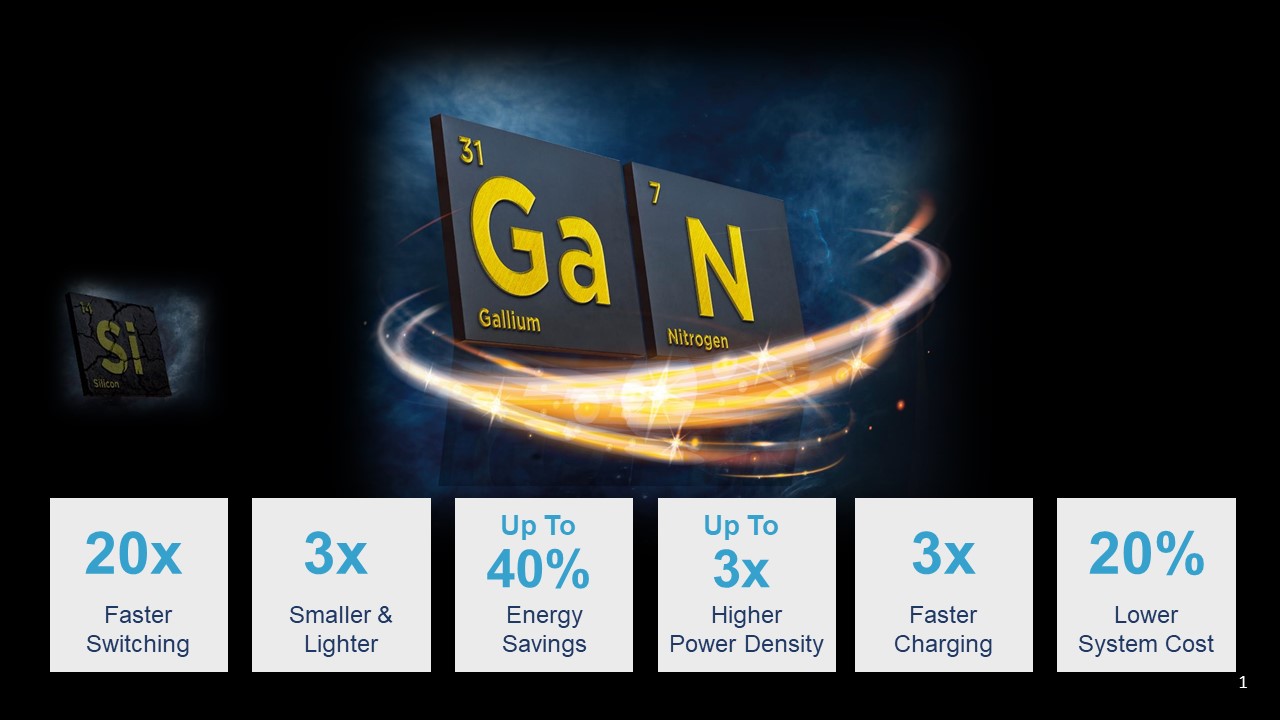
GaN enables up to 3x more power or 3x faster charging, with up to 40% energy savings in half the size and weight of legacy silicon. Navitas’ GaNFast power ICs integrate GaN power and drive plus protection and control to deliver the simplest, smallest, fastest and highest performance.
The International Energy Authority (IEA) has defined an ‘ambition gap’ between nations’ public commitments and the target required for us all to meet the maximum 1.5°C rise in global temperatures per the Paris Accord.1
GaN is a critical enabler to address the ‘ambition gap’ as we transition from majority fossil fuel to majority renewable, electricity-based energy sources and uses.
“GaN accelerates the evolution from fossil fuels to renewable energy sources and electricity-based applications”
GaN makes electrical energy more efficient and lower cost, all of which will serve to accelerate the world’s move from coal-fired power plants to solar- and wind-based energy sources and to evolve energy applications from gas-powered transportation, buildings and industrial factories to clean, electricity-based energy.
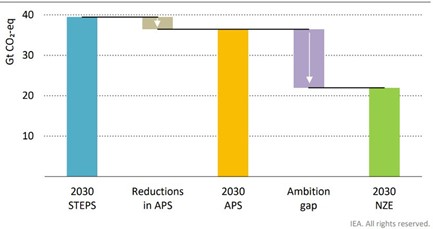
Note: STEPS = Stated Policies Scenario; APS = Announced Pledges Scenario; NZE = Net Zero Emissions by 2050 Scenario.
Definition of CO2 reduction ‘ambition gap’, from IEA’s World Energy Outlook report 2021.
Progressive Partnerships
Navitas is part of a world-wide eco-system dedicated to sustainability.
References, memberships, commitments, auditors and partners include:

Greenhouse Gas (GHG) Protocol – establishes comprehensive global standardized frameworks to measure and manage greenhouse gas (GHG) emissions from private and public sector operations, value chains and mitigation actions. Protocol defines Scope 1, 2 and 3 emissions on a corporate basis. Navitas corporate reporting uses GHG Protocol standards.

Det Norske Veritas (DNV) – respected, independent expert in assurance and risk management, including collaborations to assess and forecast benefits of next-generation GaN power ICs across worldwide, multi-market opportunities.
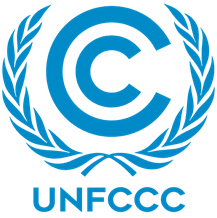
Navitas supports the UN Framework Convention on Climate Change’s (UNFCCC) Sustainable Development Goals (SDGs). This sustainability report specifically targets goals on clean, The Paris Agreement is a legally binding affordable energy, industry innovation and international treaty on climate change, infrastructure, and climate action.

Natural Capital Partners (NCP) – third-party advisors on sustainability, CarbonNeutral®
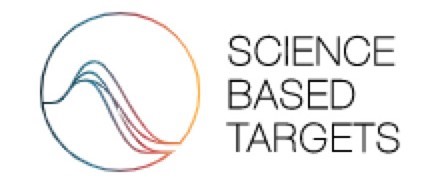
Science-Based Targets Initiative (SBTi) – in July 2021, Navitas committed to the Business Ambition for a maximum 1.5°C rise in global temperatures by the 2050 deadline set by the 2015 Paris Accord.

The Paris Agreement is a legally binding international treaty on climate change, adopted by 196 Parties at COP 21 in Paris, on 12 December 2015 and entered into force on 4 November 2016. Its goal is to limit global warming to well below 2, preferably to 1.5°C, compared to pre-industrial levels.

per ISO14040/14044. Partnered with Navitas for GaNFast power IC and 65W laptop adapter LCAs.
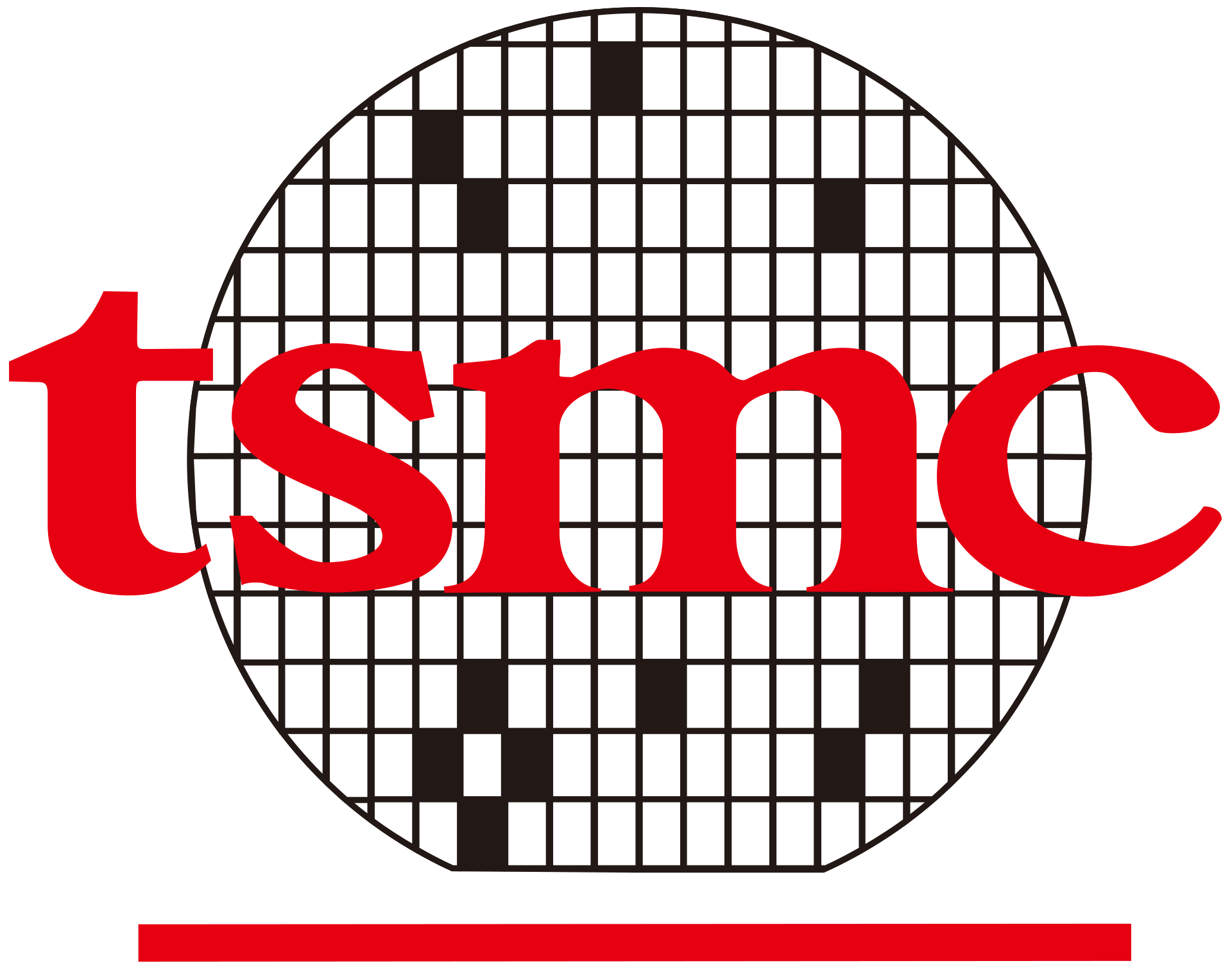
TSMC– world-class wafer manufacturing partner, with clear commitments to sustainability.
Aggressive Reduction in Corporate Emissions
Scope2 (energy purchases) and Scope 3 (up-stream activities, waste, etc.) are shown below.
On a per-unit basis, emissions were reduced in 2021 by 5%, with a goal to reduce emissions in 2022 by an additional 3% or more.
Navitas uses a comprehensive life-cycle assessment (LCA) approach to determine CO2 footprint and report based on GHG protocols.
Navitas Semiconductor GHG Emissions Summary, 2020-2022

Navitas Semiconductor Corporation GHG Emissions

Part of Navitas’ commitment to Environmental, Social and Governance (ESG) is the Navitas Net-Zero Initiative which includes annual measurement and reporting of our corporate carbon footprint, product- and system-level life-cycle assessment (LCA), focused improvement initiatives internally, with our customers and our suppliers and investment to support Sustainable Development Goals.
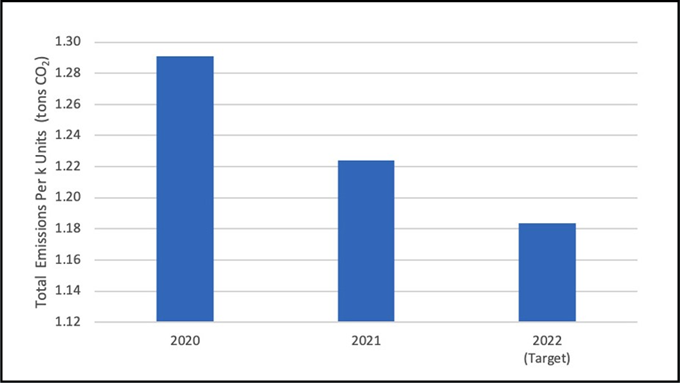
GaN: Up to 10x CO2 Reduction vs. Legacy Silicon
In 2020, a GaN power FET had a 4x reduction in CO2 versus a legacy silicon FET. When Navitas’ proprietary lateral GaN integration is considered (including the critical monolithic
integration of GaN power and GaN drive) the equivalent features and functionality increase this to a 5x benefit.
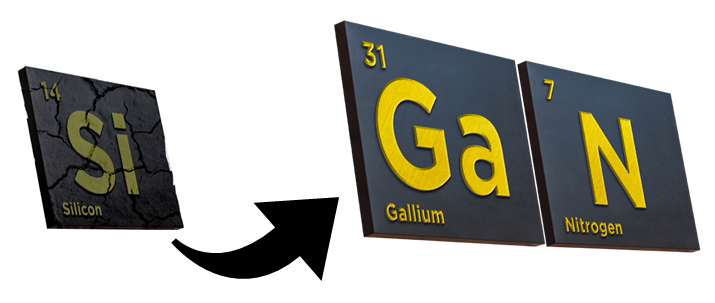
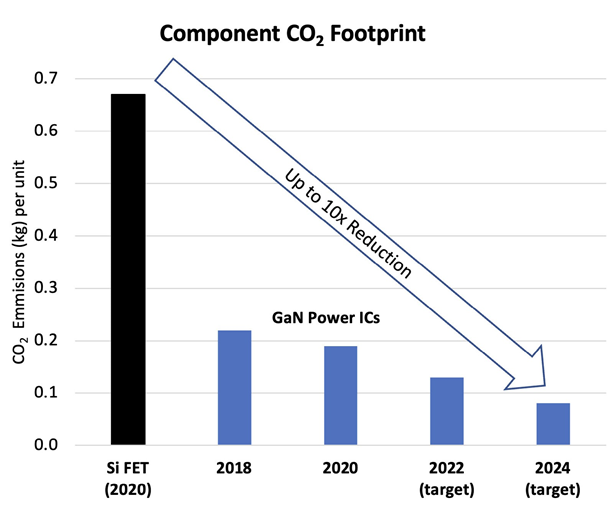
New GaN IC generation released every 10-12 month
Helping Customers Meet CO2 Goals
GaN power ICs enable power and charging systems to operate at up to 20x higher frequency than legacy silicon, which means up to 3x higher power, or 3x faster charging in half the size and weight, and with up to 40% energy savings ‘in use’. These application benefits bring commercial benefits to Navitas customers and end-users and deliver positive environmental benefits. Examples include:
b) Higher-frequency GaN operation translates into fewer, smaller passive components (magnetics, filters, capacitors, etc.) and mechanical components (PCB, housing, heatsinks, etc.) reducing oil/refinement demand and lowering shipping costs and CO2 footprint.
c) Higher-efficiency operation reduces in- use energy consumption.
Third-party total life-cycle analysis of 65W charger upgrade from silicon to GaN power ICs.
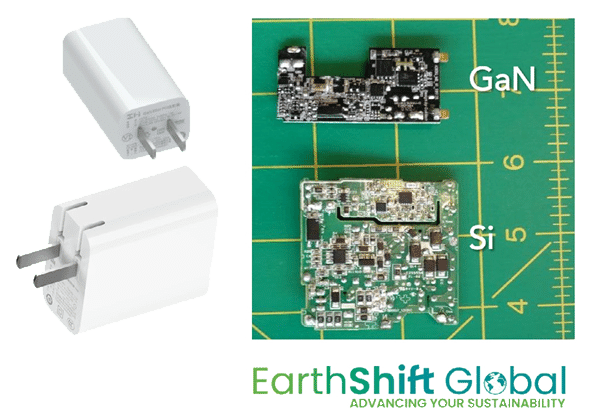
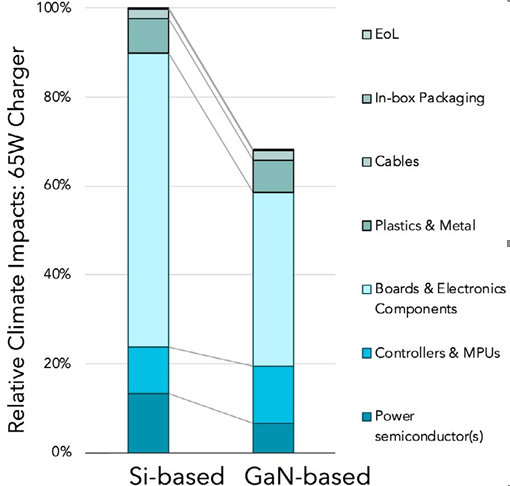
Market Catalysts for Change
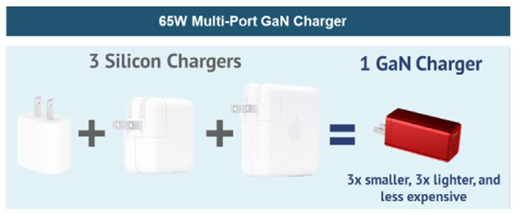 In addition to a like-for-like reduction, there are several market-driven catalysts that help to reduce CO2 footprint. Universal Serial Bus (USB) ‘Type-C’ connectors and the Power Delivery (PD) protocol standardize charging and enable a mix-and-match of chargers and mobile devices.
In addition to a like-for-like reduction, there are several market-driven catalysts that help to reduce CO2 footprint. Universal Serial Bus (USB) ‘Type-C’ connectors and the Power Delivery (PD) protocol standardize charging and enable a mix-and-match of chargers and mobile devices.
Mobile suppliers can now ship their mobile devices without a custom, dedicated charger in the box, which allows consumers to use an existing charger or purchase a small, lightweight, fast & efficient charger … both eliminating material and energy waste.”
Another change accelerated by GaN is the introduction of higher power multi-port chargers – for example, a 65W
3-in-1 (2x Type-C, 1x Type-A) charger that can fast-charge three independent mobile devices (phone, tablet, laptop or earbuds) simultaneously at a third the size, weight and retail price of separate chargers.
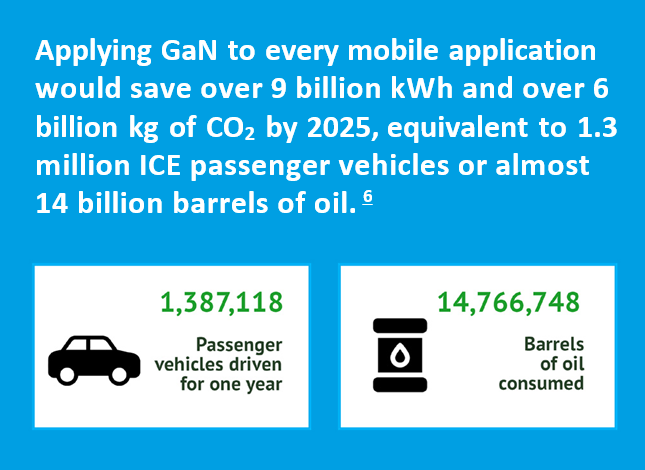
Data Centers:
Save Over 10 million tons CO2 and $1.9 billion per year


25% Cost Reduction Accelerates Residential Solar Adoption
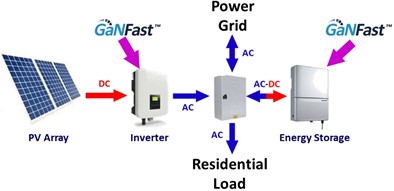
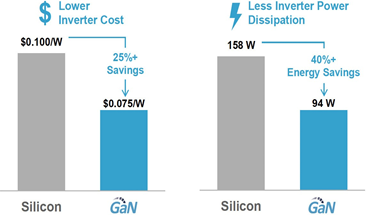
Accelerating EV Adoption by Three Years, Reducing Road-Sector Emissions by 20%
GaN technology is critical to addressing the design and sustainability challenges facing eMobility manufacturers and to driving the mass uptake of EVs. There are three major EV power applications which benefit from GaN: on-board charging (OBC), DC-DC conversion, and traction drive.
Silicon Carbide (SiC) is another ‘wide-band-gap’ material like GaN, and around 15 years more mature in the market, so has some adoption in the eMobility market, especially for very high-power traction drives in trucks and buses. However, SiC’s slower switching speed and lack of integration potential means it cannot achieve the system speed, efficiency and density delivered by GaN.
single-motor to in-wheel motors demands the high-efficiency, small-size benefits of GaN.
A transition from silicon to GaN power ICs could accelerate worldwide adoption of EVs by three years and reduce road-sector emissions by 20%/year by 2050. 3
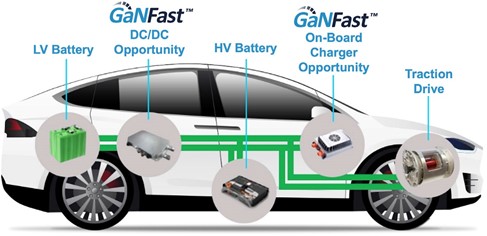
Every GaN IC Shipped Saves 4 kg CO2
Based on 2020 figures, every GaN power IC shipped reduces CO2 emissions by over 4 kg versus legacy silicon chips.2
Navitas is committed to corporate and industry-wide electrification innovations and reductions in CO2, as we strive to achieve the goals set out by the Paris Accord.
By the end of December 2021, over 35,000,000 GaN power ICs had been shipped into the mobile fast charger market, achieving over 12.6 GWh energy saved and over 9,000 tons CO2 reduced in use, plus 50,000 tons from dematerialization.
Navitas’ expansion into the higher power markets of data center, solar and electric vehicles will accelerate these energy and CO2 savings.
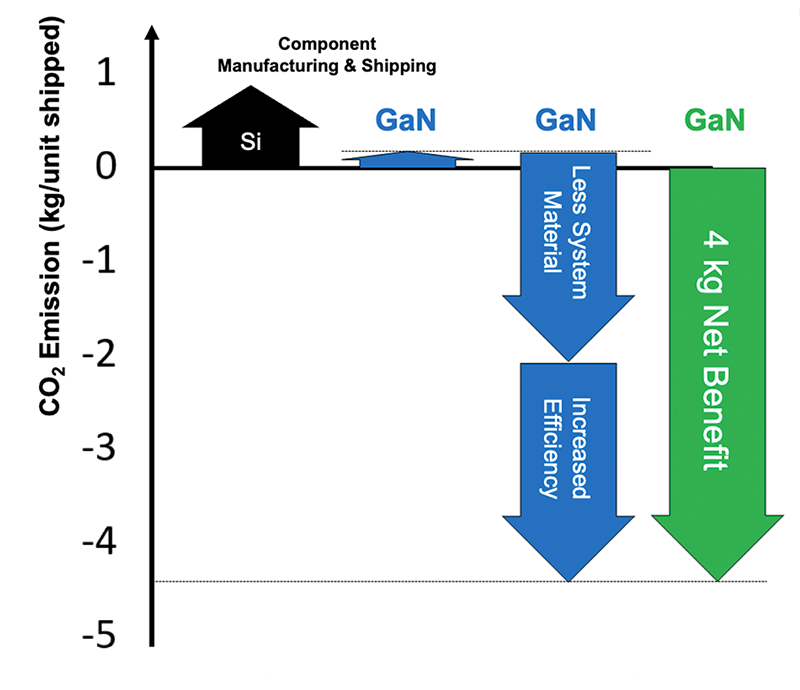
By December 2021: Navitas GaN had saved >59,000 tons CO2
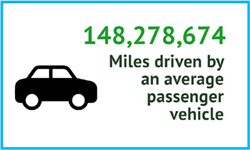
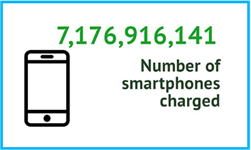
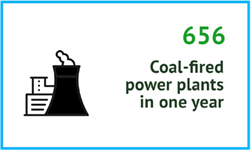

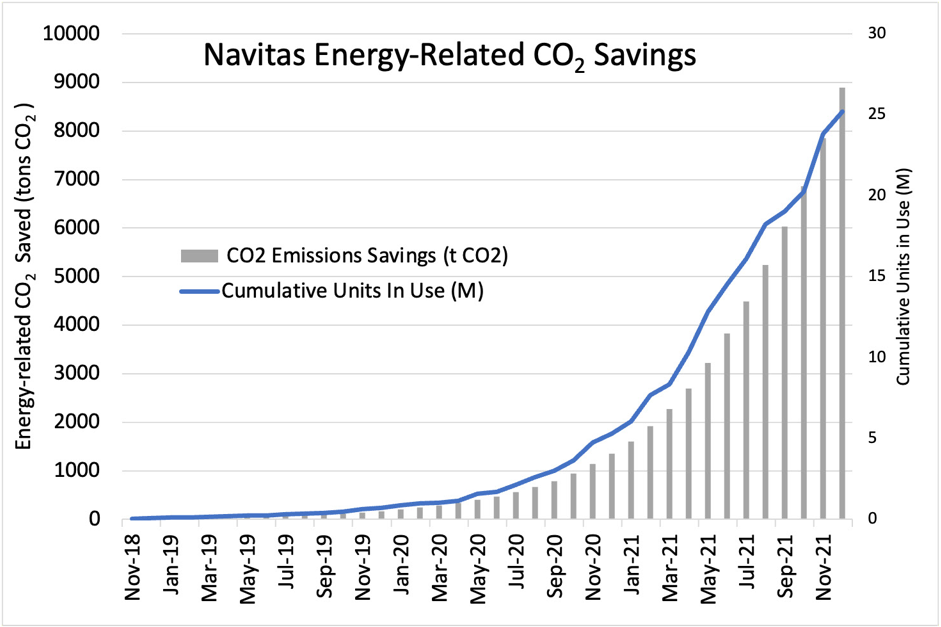
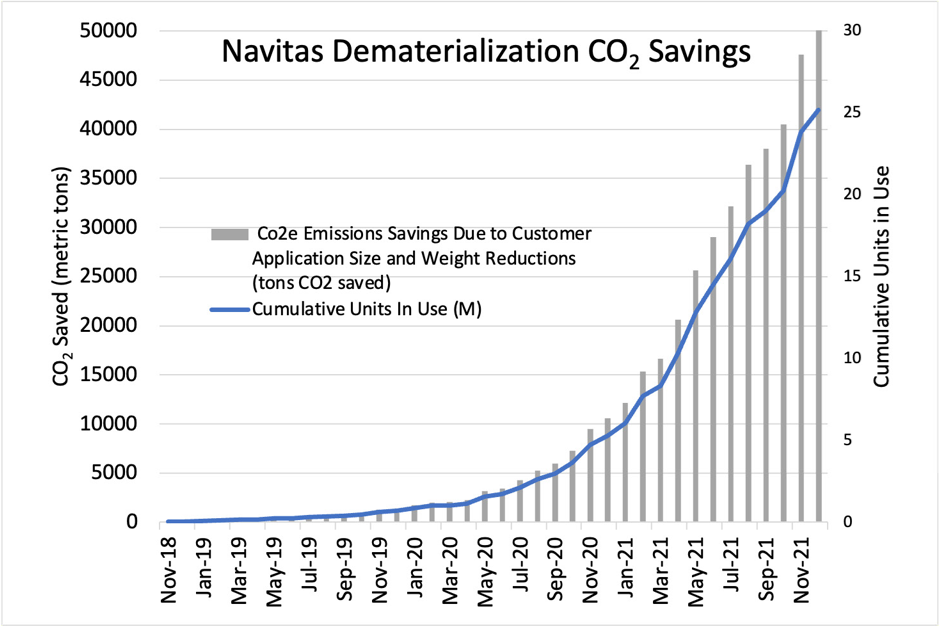
References and Citations
1 The International Energy Agency’s (IEA’s) 2021 “World Energy Outlook” provides an indispensable guide to the opportunities, benefits and risks ahead at this vital moment for clean energy transitions. https://www.iea.org/reports/world-energy-outlook-2021 “Energy Efficiency 2021” is the IEA’s annual update on global developments in energy efficiency. The 2021 edition explores recent trends in energy efficiency markets at the economy-wide and sectoral levels, including developments in policy and investment. https://www.iea.org/reports/energy-efficiency-2021
2 Up to 10x lower footprint: Navitas and Earth-Shift Global analysis. 4x lower for 2021, 10x lower by 2022 per life-cycle analysis. Up to 30% per Navitas and Earth-Shift Global estimated based on 65W charger per life-cycle analysis
3 DNV estimate for 75%-adoption milestone pull-in, total road sector benefit
4 From Navitas information, DNV GL, EPA, IEA, International Renewable Energy Agency (IRENA). Derived from demand and energy efficiency CO2 reduction of 1.4 Gt; assumes a $0.12 / kWh cost of electricity and a carbon to energy ratio of 0.00071 tons / kWh, aligned with the EPA’s marginal emission rate.
5 Per EPA equivalencies calculator: https://www.epa.gov/energy/greenhouse-gas- equivalencies-calculator
6 This sustainability report is part of Navitas’ overall Environmental, Social and Govern
7 Navitas estimate based on a) Navitas server/datacom forecast & AAAS data, b) $0.12/ kWhr, c) Si vs. GaN $/W and d) data centre loading profile.
8 Navitas est. vs. Si-based 6.2kW residential inverters assuming GaN-based inverter enables 40% reduced power loss and 25% lower inverter costs
9 Enphase Energy video testimonial at Navitas New York Investor Day, July 26th, 2021: https://navitassemi.com/enphase-customer-testimonial-navitas-semiconductor- investor-day-july-26th-2021-at-nasdaq-new-york/
10 Brusa video testimonial, Navitas NY Investor Day: https://navitassemi.com/brusa- goes-ganfast-to-reduce-the-co2-footprint-in-their-electromobility-charger-products/
This sustainability report is part of Navitas’ overall Environmental, Social and Governance commitment. For more information, refer to ESG on the Navitas website.
This report uses the term ‘C02’ as an umbrella term for ‘CO2 equivalents’ (or CO2e) as defined by the EPA.
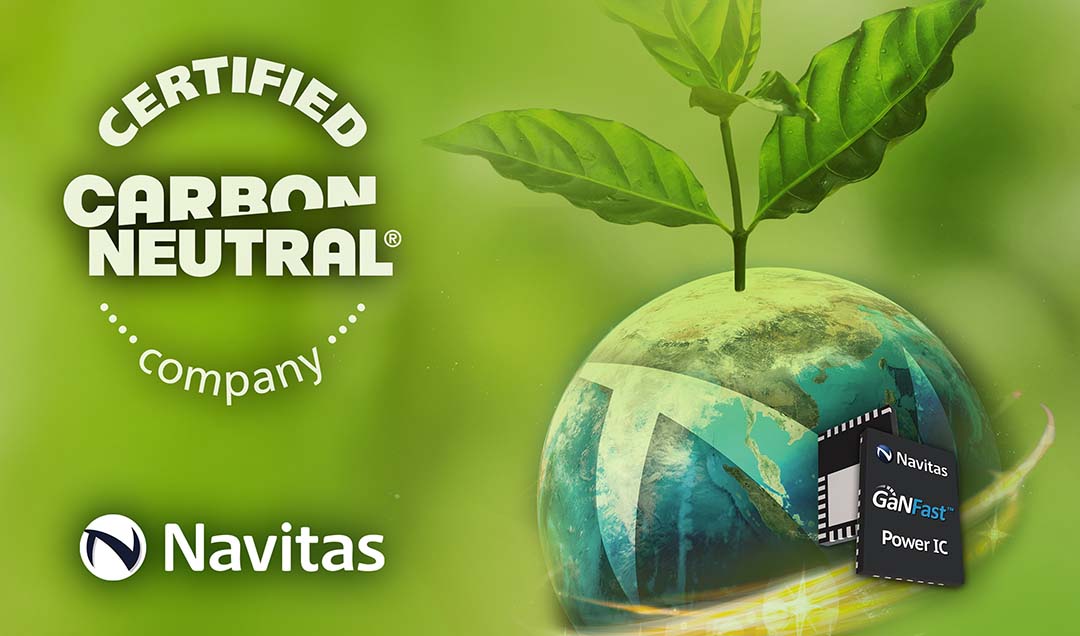
![energy-consumption-3[1]](https://navitassemi.com/wp-content/uploads/2022/08/energy-consumption-31.jpg)